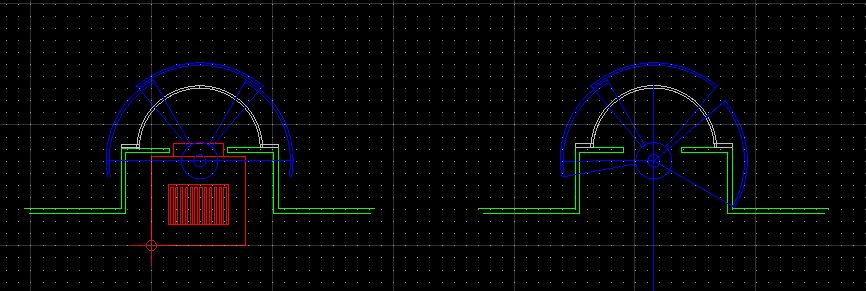 ;
;
My Final Project: All-sky camera case
This is the video presentation of my final project:
What does it do?
All-sky cameras are used to capture the passage of meteorites and bolides through the atmosphere, recording the sky throughout the night.
Generally, these cameras are permanently exposed to sunlight, in certain latitudes (between the equator and the tropics) the intense sunlight quickly reduces the useful life of the camera.
This case allows the camera lens to be covered during the day for protection and automatically opens at night.
It is a case that will protect an all-sky camera.
There are several projects that use all-sky cameras; these are networks of cameras dedicated to the search for certain objects. Here is some information about some of them:
Who’s done what beforehand?
I have found several designs for all-sky camera enclosures, but in all the cases I found, the camera remains exposed to solar radiation. Below are some links to designs of some enclosures
- Allsky Camera Casing - GBP 178.50
- All Sky Camera
- Allsky Camera Enclosure
- All-weather housing for an All-Sky camera
What did you design?
I plan to design a case that protects the camera and the lens with a transparent dome during the night when the camera is active, and a second robotized opaque dome that closes during the day when the camera is inactive to protect it from sunlight. Of course, this dome will open at night so the camera can operate.


After the sketches, I created some plans while exploring a few design programs.
I started by making a sketch of the camera I intend to use and the dome that will protect it.



I continued the design of objects by making the box that will contain the camera with the translucent dome. This time using Fusion software.

The final design is a semi-sphere that will contain the camera and the light sensor. Above the camera, there is a translucent dome, and on top of that, a retractable three-piece dome with an axis that will connect to a servo motor. Below the camera housing, there is a base where the cables pass through to the electronics box, which contains the servo control board, the servo, and the batteries. The entire design was created using the Fusion program.
What materials and components were used?

.
| Material | Details | Qty |
|---|---|---|
| 3D printer filament | ABS | 1 |
| Transparent acrylic | 2 mm | 0.05 |
| Colored acrylic | 2.3 mm | 0.16 |
| Board PCB | Placa pcb una cara | 1 |
| Connector 1x3 | PINHD-1X3/90 | 3 |
| Connector 1x2 | PINHD-1X2/90 | 1 |
| Voltage regulator | VR_REGULATOR_SOT223 | 1 |
| 1 microfarad capacitor | CAP_UNPOLARIZED | 2 |
| Microcontroller | XIAO RP2040 | 1 |
| Resistor | 1K ohm | 2 |
| Led blue | led blue clear 1206 rev mt smd | 1 |
| Servomotor | HK15138 | 1 |
| Photoresistor | SENSOR PHOTO 940NM TOP VIEW 1206 PT15-21C/TR8 | 1 |
| Battery | 9v | 2 |
| Battery holder | 9v | 2 |

Where did they come from? How much did they cost?
| Name | Package | Qty | Supply | Price unit ($) | Price total ($) |
|---|---|---|---|---|---|
| 3D printer filament | ABS | 1 | 3DMbarete | 21.3 | 21.3 |
| Transparent acrylic | 2 mm | 0.05 | Luxacril | 67 | 3.3 |
| Colored acrylic | 2.3 mm | 0.16 | Luxacril | 72 | 11.5 |
| Board PCB | Placa pcb una cara | 1 | Electromer | 5 | 5 |
| Connector 1x3 | PINHD-1X3/90 | 3 | Digikey | 0.3 | 0.9 |
| Connector 1x2 | PINHD-1X2/90 | 1 | Digikey | 0.86 | 0.86 |
| Voltage regulator | VR_REGULATOR_SOT223 | 1 | Amazon | 0.12 | 0.12 |
| 1 microfarad capacitor | CAP_UNPOLARIZED | 2 | Digikey | 0.04 | 0.08 |
| Microcontroller | XIAO RP2040 | 1 | Amazon | 15.68 | 15.68 |
| Resistor | 1K ohm | 2 | Digikey | 0.1 | 0.2 |
| Led blue | led blue clear 1206 rev mt smd | 1 | Digikey | 0.17 | 0.17 |
| Servomotor | HK15138 | 1 | hobbyking | 3.96 | 3.96 |
| Photoresistor | SENSOR PHOTO 940NM TOP VIEW 1206 PT15-21C/TR8 | 1 | Digikey | 0.41 | 0.41 |
| Battery | 9v | 2 | Todoluz | 0.5 | 1 |
| Battery holder | 9v | 2 | Amazon | 0.5 | 1 |
The prices and suppliers are for reference; for the project, all materials were provided by the FABlab CIDI.
Manufacturing of the parts
Click on each part of the image for more details on the manufacturing process.